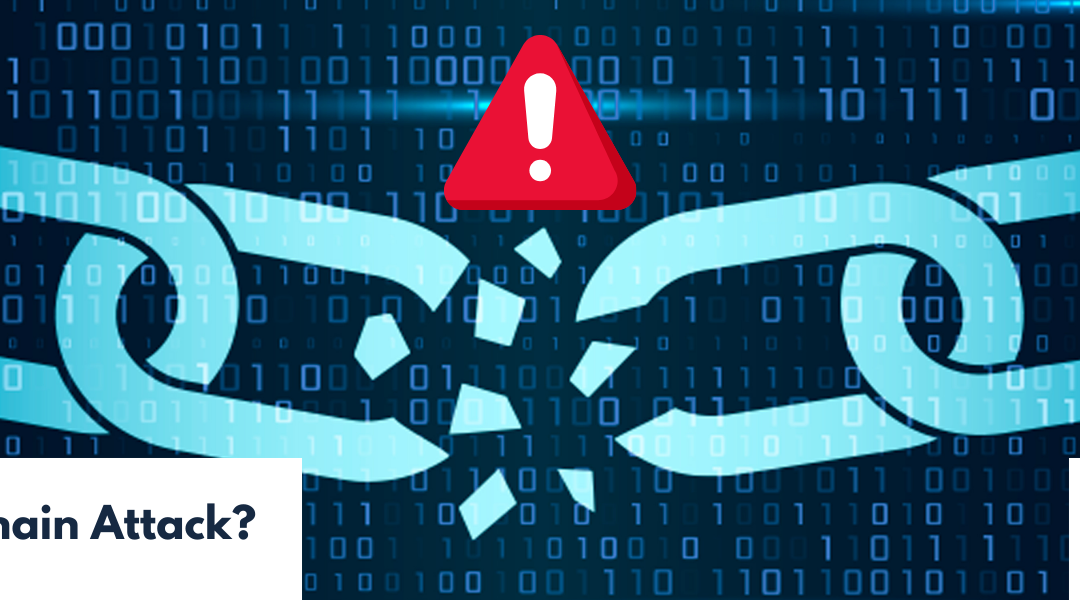A supply chain attack is a type of cyberattack that targets the weakest link in a network’s security: its suppliers or service providers. Instead of directly attacking a company or organization, cybercriminals infiltrate their target’s systems through vulnerabilities in third-party suppliers or service providers that have access to the target’s network or data.
These attacks can take various forms. For example, attackers might compromise the software or hardware of a supplier, injecting malicious code or backdoors that are then distributed to the supplier’s customers. Alternatively, attackers might target the distribution networks or update mechanisms used by suppliers to deliver their products or services, allowing them to inject malware or tampered software updates.
Supply chain attacks are particularly insidious because they can bypass traditional security measures and exploit trust relationships between the target organization and its suppliers. Additionally, since multiple organizations may be affected by a single compromised supplier, the impact of a successful supply chain attack can be widespread and severe.
Examples of supply chain attacks include the compromise of software build systems, such as the SolarWinds supply chain attack discovered in late 2020, where attackers compromised the software build process of SolarWinds, a widely used IT management software provider, to distribute malware to its customers.
Why are Supply Chain Attacks so Dangerous?
Supply chain attacks typically involve targeting trusted relationships within a chain, aiming to exploit vulnerabilities in a weaker link to gain access to larger trading partners. However, the primary concern today revolves around software supply chain attacks.
Software supply chains face significant vulnerabilities due to the nature of modern software development. Rather than being built entirely from scratch, software often relies on a multitude of pre-existing components, including third-party APIs, open-source code, and proprietary modules from software vendors.
The average software project now relies on approximately 203 dependencies. This interconnectedness poses a considerable risk: if just one of these dependencies is compromised, every business that utilizes the affected software from the vendor is potentially compromised as well. Consequently, the number of victims can multiply rapidly, creating an exponential impact.
Moreover, software components are frequently reused across various applications, meaning that a vulnerability present in one application can persist beyond its original lifecycle. This perpetuates the risk across multiple systems. Additionally, software with a limited user community is particularly susceptible, as a smaller user base decreases the likelihood of promptly identifying and addressing vulnerabilities compared to projects with a larger following.
How is a Supply Chain Attack Carried Out?
A supply chain attack can be carried out through various methods, but the general process typically involves several stages:
- Identifying Weak Links: Attackers first identify vulnerable points within the supply chain, such as third-party suppliers, service providers, or vendors with access to the target organization’s systems or data.
- Infiltration: Once a weak link is identified, the attackers seek to infiltrate the systems or networks of the targeted supplier or service provider. This could involve exploiting vulnerabilities in their software, systems, or networks, or using social engineering techniques to gain unauthorized access.
- Payload Delivery: After gaining access, the attackers deploy malicious payloads, such as malware, backdoors, or compromised software updates, into the supplier’s products, services, or distribution channels.
- Propagation: The compromised products, services, or updates are then distributed to the target organization or its customers through the supply chain. Since these come from a trusted source, they are often accepted without suspicion.
- Execution: Once the compromised software or service is deployed within the target organization’s environment, the attackers can execute their malicious activities, such as stealing sensitive data, conducting surveillance, or disrupting operations.
- Covering Tracks: To maintain access and avoid detection, attackers may cover their tracks by removing traces of their presence, creating backdoors for future access, or obfuscating their activities within the target organization’s systems.
Common Types of Supply Chain Attacks
- Software Supply Chain Compromise: Attackers infiltrate the software development process to inject malicious code or backdoors into legitimate software packages. These compromised software packages are then distributed to customers, potentially allowing attackers to gain access to their systems or data.
- Vendor Compromise: Attackers target third-party vendors or service providers that have access to the target organization’s systems or data. By compromising these vendors, attackers can gain a foothold in the target organization’s network.
- Hardware Supply Chain Compromise: Attackers tamper with hardware components or devices during the manufacturing or distribution process. This can involve inserting malicious components, firmware, or hardware implants into products before they reach customers. Compromised networking equipment or IoT devices are examples of targets for this type of attack.
- Distribution Channel Compromise: Attackers target the distribution channels used by suppliers to deliver their products or updates. By compromising these channels, attackers can inject malware or tampered software updates into legitimate products or services. This can lead to widespread distribution of malicious software to unsuspecting customers.
- Credential Theft and Credential Stuffing: Attackers target suppliers or service providers to steal credentials or authentication tokens, which they then use to access the systems or data of their customers. This can lead to unauthorized access to sensitive information or resources within the target organization’s network.
- Phishing and Social Engineering: Attackers use phishing emails or social engineering tactics to trick employees of suppliers or service providers into revealing sensitive information or granting access to their systems. Once inside, attackers can pivot to target the customer’s network or data.
- Browser-based attacks: These attacks exploit vulnerabilities in web browsers to compromise users’ systems. They can involve malicious websites, browser plugins, or scripts that exploit browser vulnerabilities to install malware or steal sensitive information.
- Software attacks: Software attacks target vulnerabilities in applications or operating systems to gain unauthorized access, disrupt operations, or steal data. Examples include exploiting software bugs, buffer overflows, or insecure configurations to execute malicious code.
- Open-source attacks: Attackers exploit vulnerabilities in open-source software or libraries to compromise systems or applications that use them. Since open-source components are widely used and often shared across projects, a vulnerability in one component can have far-reaching consequences.
- JavaScript attacks: JavaScript attacks involve exploiting vulnerabilities in JavaScript code running in web browsers to execute malicious actions. These attacks can range from cross-site scripting (XSS) to code injection, where attackers inject malicious JavaScript code into web pages to steal information or perform unauthorized actions.
- Magecart attacks: Magecart attacks target e-commerce websites by injecting malicious code into their payment processing pages. This code captures payment information entered by users and sends it to the attackers, allowing them to steal credit card details and other sensitive data.
- Watering hole attacks: In watering hole attacks, attackers compromise websites frequented by their target victims. They inject malicious code into these websites, exploiting vulnerabilities in visitors’ browsers or plugins to deliver malware or conduct reconnaissance on target organizations.
- Cryptojacking: Cryptojacking involves hijacking users’ computing resources (such as CPU or GPU power) to mine cryptocurrencies without their consent. Attackers typically achieve this by infecting websites, mobile apps, or devices with cryptocurrency mining scripts, which consume system resources and degrade performance.
How to Prevent and Detect a Supply Chain Attack
Supply chain attacks present a growing concern for businesses, affecting vital relationships with partners and suppliers. They are notoriously difficult to detect, and past validation of software does not guarantee its security today.
To address these risks effectively, organizations must assess vendors rigorously and implement strategies to mitigate supply chain vulnerabilities. This includes deploying advanced prevention, detection, and response technologies.
Here are recommendations for enhancing supply chain security and minimizing the risk of falling victim to attacks:
Vendor Assessment and Due Diligence:
- Conduct thorough assessments of vendors and suppliers before engaging with them. Evaluate their security practices, policies, and track record.
- Establish criteria for vendor selection, considering factors such as security certifications, compliance with regulations, and reputation in the industry.
- Regularly review and update vendor contracts to include specific security requirements and responsibilities.
Risk Management and Mitigation:
- Identify and assess potential risks within the supply chain, including dependencies on critical vendors and suppliers.
- Implement risk mitigation strategies, such as diversifying suppliers, reducing reliance on single points of failure, and establishing contingency plans.
- Monitor the security posture of vendors and suppliers continuously, using tools and techniques such as threat intelligence, security assessments, and audits.
Security Controls and Best Practices:
- Implement strong security controls and best practices throughout the supply chain, including encryption, access controls, and secure configurations.
- Enforce the principle of least privilege, limiting access to sensitive data and systems only to those who need it.
- Regularly patch and update software and systems to address known vulnerabilities and reduce the risk of exploitation.
- Educate employees and stakeholders about security risks and best practices, including phishing awareness and social engineering prevention.
Monitoring and Detection:
- Deploy security monitoring tools and technologies to detect suspicious activities and anomalies within the supply chain.
- Implement endpoint detection and response (EDR) solutions to monitor endpoints for signs of compromise and malicious behavior.
- Utilize network intrusion detection systems (IDS) and intrusion prevention systems (IPS) to monitor network traffic and detect potential threats.
- Implement log management and analysis to track and analyze events and activities across the supply chain, enabling rapid detection and response to security incidents.
Incident Response and Containment:
- Develop and regularly test incident response plans to ensure a coordinated and effective response to supply chain attacks.
- Establish communication channels and protocols for reporting and responding to security incidents with vendors and partners.
- Implement containment measures to limit the impact of a supply chain attack, including isolating affected systems and networks and restoring clean backups if necessary.
- Behavioral-Based Attack Detection: Employ solutions incorporating behavioral-based analysis, such as indicators of attack (IOAs). Machine learning (ML) technologies are crucial for detecting patterns in numerous daily attacks, surpassing human capabilities.
- Threat Intelligence: Stay ahead of potential supply chain attacks with threat intelligence. This informs organizations about emerging threats and equips them with the knowledge to proactively defend against them.
- Proactive Services: Given the complexity of supply chains, it’s challenging for organizations to fully shield themselves from attacks. However, proactive measures can bolster readiness. For example:
- Conduct third-party risk assessments, including testing software before deployment and enforcing security policies.
- Implement Zero Trust principles to continuously validate and monitor users, preventing unauthorized access.
- Utilize malware prevention tools like antivirus software to automatically scan for and block malicious code.
- Adopt browser isolation to sandbox webpage code before execution, intercepting malware before it reaches end-user devices.
- Detect and manage shadow IT usage with a cloud access security broker (CASB) to identify potential vulnerabilities.
- Enable patching and vulnerability detection to address known security issues in third-party software and applications.
- Implement measures to prevent zero-day exploits, such as browser isolation and robust firewall configurations.
Penetration Testing:
Penetration testing can help detect supply chain vulnerabilities by simulating real-world attack scenarios against the organization’s systems and networks. Penetration testers may attempt to exploit weaknesses in third-party software, vendor interfaces, or communication channels to gain unauthorized access. By identifying these vulnerabilities through controlled attacks, organizations can take proactive steps to address them before they are exploited by malicious actors.
Penetration testing provides insights into the effectiveness of existing security controls and defenses against supply chain attacks. Organizations can use the findings from penetration tests to strengthen security measures, such as access controls, network segmentation, and intrusion detection systems, to prevent unauthorized access and mitigate the impact of supply chain attacks.
Vulnerability Assessment:
Vulnerability assessment involves scanning systems, networks, and applications for known vulnerabilities and weaknesses. This process can help detect vulnerabilities in third-party software, dependencies, or components within the supply chain. By conducting regular vulnerability scans and assessments, organizations can identify and prioritize vulnerabilities that could be exploited in a supply chain attack.
Vulnerability assessment enables organizations to take proactive measures to mitigate risks and prevent supply chain attacks. This may include patching known vulnerabilities, implementing security updates, and enforcing security policies for third-party vendors and suppliers. By addressing vulnerabilities identified through vulnerability assessments, organizations can reduce their exposure to supply chain attacks and improve overall security posture.
The AI-driven Cyberattacks are Here to Stay; Strengthen your Cybersecurity
Hackers are employing cyberattacks in extremely cunning ways and 75% of cyberattacks to gain access were malware-free.
This implies that security breaches and cyberattacks are here to stay, and to reduce our business losses, both in terms of money and data, we need to strengthen our cybersecurity.
So what are you waiting for, contact us now to know how we can cyber-secure your business against AI and other exploitations.
Read the Third Blog Post of NanoMatriX’s Cybersecurity Series Here.
About NanoMatriX Technologies Limited
NanoMatriX is a specialist in providing document and brand protection solutions. To solve our customer’s problems, we provide the following product and service categories:
- Brand-/document protection platforms
- Custom Software development
- Cybersecurity services
- Anti-counterfeiting products
- Consulting services
The competitive advantages of NanoMatriX are:
- Two decades of experience helping brand owners and government agencies fight product and document crime worldwide.
- A unique combination of rare-to-find skills in linking physical overt, covert, and forensic security features with secure digital features.
- Proven rigorous application of top cyber security and data privacy protection standards. Multi-lingual, multi-cultural, and collaborative corporate culture.
NanoMatriX Technologies Limited is committed to the highest standards of cyber security, data privacy protection, and quality management. Our systems are certified and compliant with leading international standards, including:
- ISO 27001: Ensuring robust Information Security Management Systems (ISMS).
- ISO 27701: Upholding Privacy Information Management Systems (PIMS) for effective data privacy.
- ISO7 2701: Implementing ISMS for cloud-hosted systems, ensuring cybersecurity in cloud environments.
- ISO 27018: Adhering to PIMS for cloud-hosted systems, emphasizing privacy in cloud-hosted services.
- ISO 9001: Demonstrating our commitment to Quality Management Systems and delivering high-quality solutions.






Recent Comments